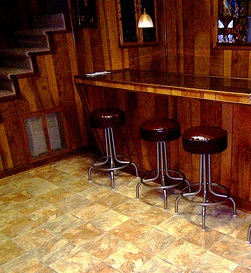
Vinyl flooring is usually resistant to moisture. It will take any number of spills you can imagine and keep on going. The trouble starts when the persistent presence of moisture underneath the floor corrodes the vinyl floor adhesive, causing the edges of the flooring to pull away and possibly causing discoloration and stain rings in your vinyl flooring.
Check for Moisture Sources Before Installing Vinyl Floors /Moisture can come from any number of sources; some of them are commonly overlooked by flooring contractors. If the room you are installing vinyl flooring in is below ground level, it is very important not to overlook the presence of moisture. Installing vinyl flooring should involve thoroughly preparing the concrete subfloor and checking for any water sources that might infiltrate the vinyl flooring.
Installing Vinyl Flooring Flooring installers check the moisture level of concrete at the time of installation. If the levels are suitable at that time, flooring may be installed. If something were to change (i.e. heavy rains after a long drought season, changing landscaping, inadequate drainage) the home may be subject to vapor emission.
You may have even had significant emissions you were unaware of prior to changing the flooring because carpet is porous and absorbs more than vinyl, which is nonporous and traps moisture underneath it. When installing vinyl flooring in a high moisture area, dry the floor first; this may take several days to weeks.
Moisture and Vinyl Adhesive Purchase a vinyl with built-in mildicides that won’t allow mold growth. Buy an adhesive that has a sealant built in, making sure it is compatible to the flooring. If your concrete floor is too damp, consider other flooring options, like stone tile. You’ll usually get the best results from tearing up an existing floor before installing new (and most flooring manufacturers will not honor warranties on material installed over old flooring). There are, however, times when it is advisable, for example, to encapsulate old flooring containing asbestos or to add an extra level of moisture protection. Moisture and Alkalinity Under Vinyl Flooring Another important factor that can be overlooked is the concrete’s alkalinity; concrete naturally has a high alkaline content. This isn’t something to be concerned about, as the alkaline levels usually drop to acceptable levels over time. Sometimes this drop doesn’t occur or doesn’t occur soon enough or to the extent needed to protect your vinyl flooring.
An alkaline subfloor will attract and trap moisture. This moisture mixed with the alkaline can cause adhesion failure and discoloration. You can test your floor with a pH test kit, similar to the one that’s used for swimming pools. If the concrete does prove to be too alkaline, you may consider applying a concrete sealant to protect the subfloor against moisture before installing vinyl tile flooring or any other type of flooring material for that matter.
Sealing out Moisture Against Vinyl Flooring Before installing vinyl flooring you should also make sure that adjacent fixtures are water tight. The most common source of moisture is the toilet. The pipe that comes up through the floor is also an easy avenue for moisture infiltration. A high quality, flexible silicone sealant, applied around the ring, should help keep the vapor emissions down. In the past these pipes were cast iron, but are usually plastic now. People often blame leaks on the wax seal directly under the toilet when the problem is actually this gap between the pipe and the flooring material.





